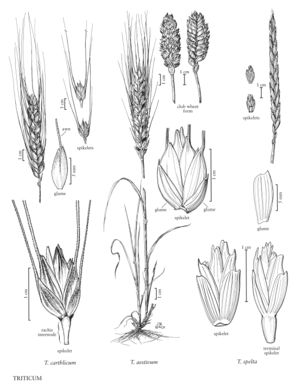Triticum spelta
Culms 80-120 cm; nodes glabrous or pubescent; internodes hollow, even immediately below the spikes. Blades 12-20 mm wide, sparsely pubescent. Spikes 6-20 cm, about as wide as thick, slender, almost cylindrical, narrowing distally; rachises glabrous or sparsely hairy at the nodes and margins, disarticulating with pressure, disarticulation units barrel-shaped or wedge-shaped. Spikelets 12-16 mm, with 3-5 florets, 1-3 seed-forming. Glumes 5-10 mm, coriaceous, tightly appressed to the lower florets, truncate, with 1 prominent keel, keel winged to the base, terminating in a tooth; lemmas 8-12 mm, toothed or awned, awns on the lower 2 lemmas to 10 cm, the third lemma sometimes awned, awns to 2 cm; paleas not splitting at maturity. Endosperm usually flinty. Haplomes AuBD. 2n = 42.
Discussion
In the Flora region, Triticum spelta is grown for the specialty food and feed grain markets. It is known for yielding a pastry-grade flour not suitable for bread making unless mixed with T. aestivum, the bread-quality flour. Modern plant breeding programs are improving its gluten profile to upgrade its bread-making quality. Consequently, claims that T. spelta is a safe option for consumers with gluten intolerance should be treated with caution.
The ability of Triticum spelta to break under pressure into barrel-shaped units similar to those found in Aegilops cylindrica distinguishes it from all other members of Triticum.
Selected References
None.
Lower Taxa
"decumbent" is not a number."-3timesthelengthof" is not declared as a valid unit of measurement for this property.
